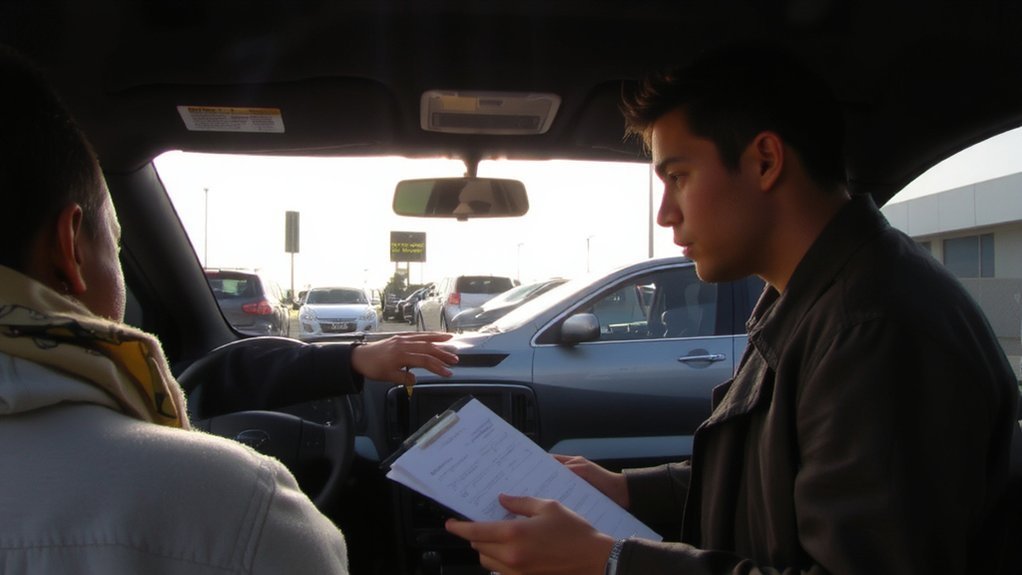When buying a used car, you’re better off prepared: research local sold prices, run the VIN and history reports, set a target and a firm walk‑away price, and get multiple written quotes. Stay calm, document everything, and don’t commit until an independent inspection clears the car—next, learn the negotiation steps that actually work.
Research the Local Market Value
How much should you expect to pay in your area? You’ll check local listings on sites like Autotrader, Cars.com and Craigslist to collect comparable vehicles by make, model, year, trim, mileage and condition.
Filter for similar options and note asking prices, recent sale posts and time on market.
Cross-reference price guides (Kelley Blue Book, NADA, Edmunds) to find suggested private-party and dealer values, then adjust for local demand, seasonal trends and common regional issues.
Run the VIN for history and identify needed repairs or recalls that lower value. Track average sale prices rather than list prices, and establish a realistic target price and walk-away maximum before you contact sellers. Document your findings in a spreadsheet or notes app to compare offers quickly and priorities.
Gather Multiple Dealer Quotes
With your target price and walk-away limit in hand, start contacting several nearby dealers to request firm, written quotes for the exact vehicle (VIN, trim, mileage and options). Insist on an out-the-door price that itemizes taxes, registration, dealer fees and any add-ons so you can compare apples to apples.
Ask each dealer how long the quote is valid and whether the vehicle’s condition or mileage could change the price. Get the salesperson’s name, phone and email, and request the quote as a PDF or email you can save.
If you plan to trade in, supply your car’s details and ask for a separate trade-in offer. Use the comparisons to identify the best deal and narrow which dealers you’ll negotiate with over the phone too.
Use Data-Driven Negotiation Tactics
Because dealers price cars against local demand and inventory, use hard data to control the conversation: cite recent sold prices for the same VIN/trim, trim-specific guides (KBB, NADA, Black Book), market comps from listing sites, and the vehicle history report to rebut glossed-over issues.
Then quantify your offer: show the median sold price, adjust for mileage, condition, and options, and present a written justification with links or printouts.
Ask the salesperson to explain price gaps relative to your data; stay calm and repeat specifics.
Use time-stamped listings to prove supply changes and leverage days-on-market.
If they won’t negotiate to a fair range, be prepared to walk.
Data makes negotiations objective, forces concessions, and prevents emotional overpaying.
Bring printed evidence and reference it during talks.
Recognize Information Asymmetry and Vehicle History Risks
Data gives you leverage, but sellers and dealers still control information you can’t see, and that gap creates real risks.
You should assume history reports are incomplete: salvage titles, flood damage, undisclosed accident repairs, frame work, and odometer rollbacks can be masked.
Demand the VIN, review multiple vehicle-history sources, and compare maintenance records against physical condition.
Always get a pre-purchase inspection by an independent mechanic who checks suspension, rust, leaks, and wiring.
During the test drive, listen for noises and verify electronics and safety systems.
Use discovered issues to quantify repair costs and adjust your offer accordingly.
Document everything, keep copies of reports, and be realistic about warranty limits and remaining service life.
Factor a documented risk premium into your negotiation math and timing.
Employ Strategic Walking-Away Techniques
If the seller won’t meet your pre-set limits, be ready to stand up and leave.
Don’t threaten empty walks; mean it.
Pause, summarize your offer, and state your bottom line calmly.
If they stall, get up—physically moving signals seriousness.
Use silence after stating your price; it forces them to respond.
Have an exit plan: time, transport, and alternatives so you don’t cave from inconvenience.
Leave contact info only if you’re genuinely willing to return.
After walking, give them a set window to call; otherwise move on.
Walking away preserves leverage, avoids impulse concessions, and often brings better terms later.
Remember: your willingness to leave is one of your strongest negotiating tools.
Stay polite, brief, and consistent—don’t negotiate under pressure or fatigue ever again today.
Maximize Savings by Leveraging Success Rates and Dealer Margins
When you know typical dealer margins and the likelihood your offer will be accepted, you can target negotiations that actually move the needle. Research invoice-to-list spreads, local demand, and recent sale prices so you’re aware how much room dealers have.
Set an initial offer based on a realistic success rate—lower if success is unlikely, firmer when data shows closings near your target. Use that success-rate estimate to choose concessions: a slightly higher price for faster financing, or insist on add-ons if closing odds rise.
Keep your walk-away point tied to dealer margin, not emotion. That discipline lets you pressure dealers toward acceptable deals while preserving leverage and avoiding overpayment.
Track interactions and adjust offers dynamically as new information changes success probabilities and margin estimates.
Conclusion
You’ve done the homework, set limits, and got competing quotes, so stay firm and patient at the table. Use VIN reports, sold listings, and itemized out‑the‑door pricing to support offers, and insist on an independent inspection. Negotiate with calm, documented facts, be ready to walk away, and you’ll force fairer terms. That discipline converts research into savings and keeps you from paying above true market value. You’ll drive a better deal every single time, period.
